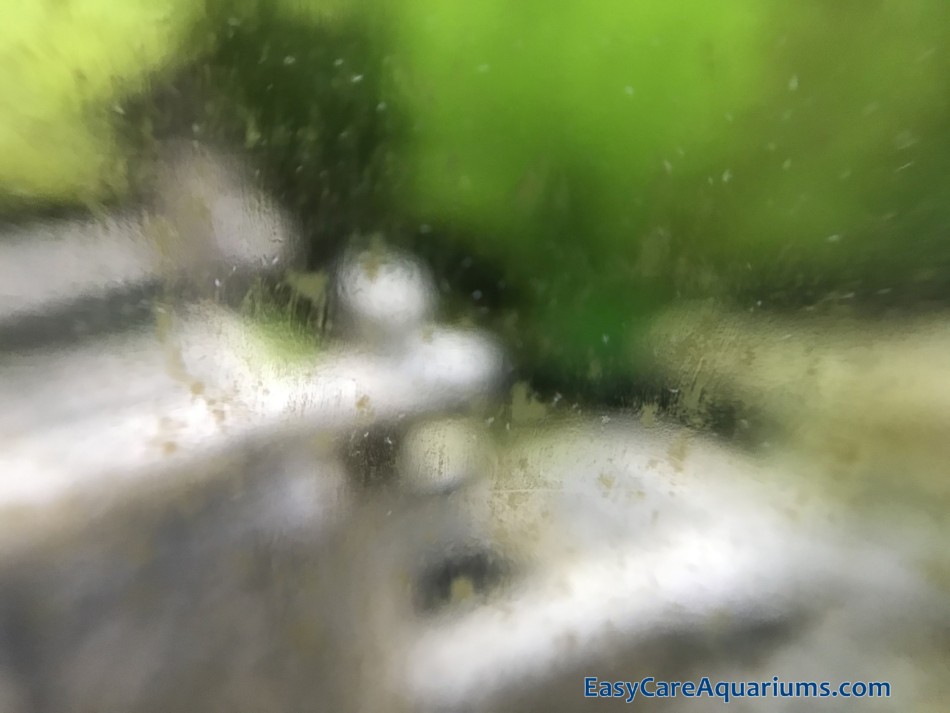This article may contain some affiliate links to products. The links provide me a small percentage of commission but do not cost you anything extra to use. (See full disclosure statement here ).
).
A small amount of algae in an aquarium is a natural and healthy thing. It shows that your tank has achieved a balance. But what can you do if the algae starts to take over and spoils the look of your tank?
There are several different types of aquarium algae. Some are more common than others. And some are easier to get rid of than others.
Let’s take a look at the most common types of aquarium algae, ways to get rid of them, and ways to reduce or prevent them.
7 Common Types Of Aquarium Algae
- Diatoms – Brown Dusty algae common in a new tank setup, on the substrate and/or the glass.
- Hair/Thread Algae – Soft green and wispy. On plants, glass, substrate and tank decorations.
- Green Dust Algae – Soft dusty algae coating on glass but can spread all over a tank.
- Black Beard Algae (BBA) – Tufty looking black algae generally grows in small clumps and spreads.
- Green Spot Algae – Hard green algae. Starts of as spots, but if left will join up and become a wall.
- Blanket Weed – A tough green algae that attaches itself to hardscape and forms a blanket covering.
- Green Water Algae – Bright green algae that lives in the water column turning the water green.
There are other types of aquarium algae such as Fuzz Algae, Staghorn Algae and Blue-Green Algae. So you need to look out for these and other types of algae too.
Tip: Different types of algae have different textures. For example: some are dusty, some are soft, some are fluffy or stringy and others are hard in texture. The texture and the way each algae type attaches itself makes a difference to how you go about removing it.
How To Remove Algae From Your Aquarium
The best way to remove algae from your aquarium will depend on the type of algae and it’s texture. It also depends on how well the algae has attached itself and what it has attached itself to.
Below are some helpful tools and ways to remove different kinds of algae.
- Soft Dusty Algae Types– These can be removed from hard surfaces, including tank decorations, using an aquarium cleaning Pad/Sponge
 or Magnetic Cleaners
or Magnetic Cleaners (Amazon links) for the glass/acrylic tank walls. If it’s on plants, or the substrate, you can use a soft toothbrush to make it float into the water column to be sucked into the filter. This type of algae is probably the easiest to remove and keep on top of.
(Amazon links) for the glass/acrylic tank walls. If it’s on plants, or the substrate, you can use a soft toothbrush to make it float into the water column to be sucked into the filter. This type of algae is probably the easiest to remove and keep on top of.
- Soft Wispy Hair-Like Algae Types – These types of algae can be invasive but with a little effort and repeated tank maintenance they can be controlled or even eradicated. You can remove them from plants and tank decorations using something as simple as a dinning fork and/or a wooden BBQ skewer. Use the fork to twirl the algae around the fork just like you would if you were eating spaghetti. For smaller spaces use the wooden BBQ skewer to twirl it around the skewer like they do with candy floss/cotton candy at the fair.
- Hard Algae Types – Harder types of algae need a bit of scrubbing. Whether they are on the glass or on tank decorations they can be difficult to remove completely. But keeping on top of it is the main goal. For hard to remove algae that’s on the glass a Razor Blade Algae Scraper
 (Amazon link) is ideal. If you have an acrylic aquarium you need to choose a suitable scraper that won’t scratch the tank walls. Hard algae on tank decorations can be removed by using the razor blade scraper or a tough sponge pad depending on the size/shape/type of the decoration.
(Amazon link) is ideal. If you have an acrylic aquarium you need to choose a suitable scraper that won’t scratch the tank walls. Hard algae on tank decorations can be removed by using the razor blade scraper or a tough sponge pad depending on the size/shape/type of the decoration.
- Blanketing Algae Types – This type of algae tends to form a carpet over the bottom of the tank. But it can also envelop your plants and tank decorations if allowed to run wild. The best way to remove this is to manually scoop it up and out using your hands. It can smell really nasty if you crush it though so be careful as you remove it. You will need to remove it on a regular basis to keep it in check.
- Green Water Algae – Getting rid of green water (algae floating in your water column making the water green) can be a problem. Regular water changes help but to speed things up you can use a UV Water Sterilizer
 (Amazon link) and/or use an Algae Prevention/Solution Product
(Amazon link) and/or use an Algae Prevention/Solution Product (Amazon link) making sure that the product you use won’t harm your tank inhabitants or live plants.
(Amazon link) making sure that the product you use won’t harm your tank inhabitants or live plants.

What Causes Algae In An Aquarium?
Although Algae growth is natural if you keep an aquarium, or any kind of tank that contains at least some water, you don’t want it to take over.
But what causes excess algae?
There are several possible causes of excess algae in your tank. Below is a list of the most likely culprits.
- Lack Of Tank Maintenance – Even if you have a tank maintenance routine it’s easy to fall short sometimes. Life is often like that. But if you let things slide for too long you can find yourself with an algae problem. A little leeway is fine now and again. But do your best to keep the tank clean and the water quality up to standard on a regular basis.
- Overfeeding – Overfeeding your tank inhabitants is a common cause of excess algae growth. Uneaten food creates excess nutrients in the water column which algae loves to feed off. Just like any other plant life in your tank algae will use the nutrients to grow and spread. So be careful not to overfeed your tank even if you have fish etc that always seem to be demanding more food.
- Nutrient Imbalance – This point links closely with lack of tank maintenance and overfeeding so that’s why I’ve put it next on the list. Both of the above points create a nutrient imbalance in the water that algae thrives on. So if you’re experiencing an algae outbreak it’s worth testing your water. There are several types of Water Test Kits
 (Amazon link) available to buy so choose one that suits you.
(Amazon link) available to buy so choose one that suits you.
- Too Much Light – Most of us want our tanks to be lit so we can enjoy seeing our fish and their tankmates. But extended lighting periods can lead to algae problems. Taking your tank inhabitants and live plants into account, only light the tank for the necessary amount of hours each day. Reducing the lighting period helps to combat algae growth. And don’t forget about natural sunlight. Sunlight hitting the tank glass encourages algae. So either shield the glass on sunny days or move the tank to a more sheltered position.
- Brought In On New Plants – Algae can be brought into your aquarium by mistake. If the new plants you’ve added have algae, or algae spores, on them you could find yourself with an outbreak. It’s also possible for fish etc to accidently carry algae spores into your aquarium. Always do your best to check any plants or fish etc before you buy or add them to the tank.
Tip: Overstocking your tank can lead to, or worsen, algae problems. More fish means more poop and more nutrients in the tank for algae to thrive on. It’s always better to understock rather than overstock a tank.
How To Prevent Algae In Your Aquarium
Following on from the sections above here’s a Takeaway list with some extra helpful points
- Carry out regular tank maintenance – don’t leave it too long between sessions
- Don’t overfeed your tank – feed only what is needed
- Only light the tank for the minimum hours needed and shield the tank from sunlight
- Check new plants and fish etc for signs of algae before you add them to the tank
- Some types of algae are harder to remove than others so you need to use the best method
- If you use an algae inhibitor product make sure it’s safe for your fish and their tankmates
- Get some algae eaters. There’s lots of different fish, shrimp and snails that love to eat algae. While they won’t fix the problem for you they will help you to keep it under control going forward.
- Use a UV Sterilizer and/or and algae prevention product that won’t harm your tank inhabitants or plants.


